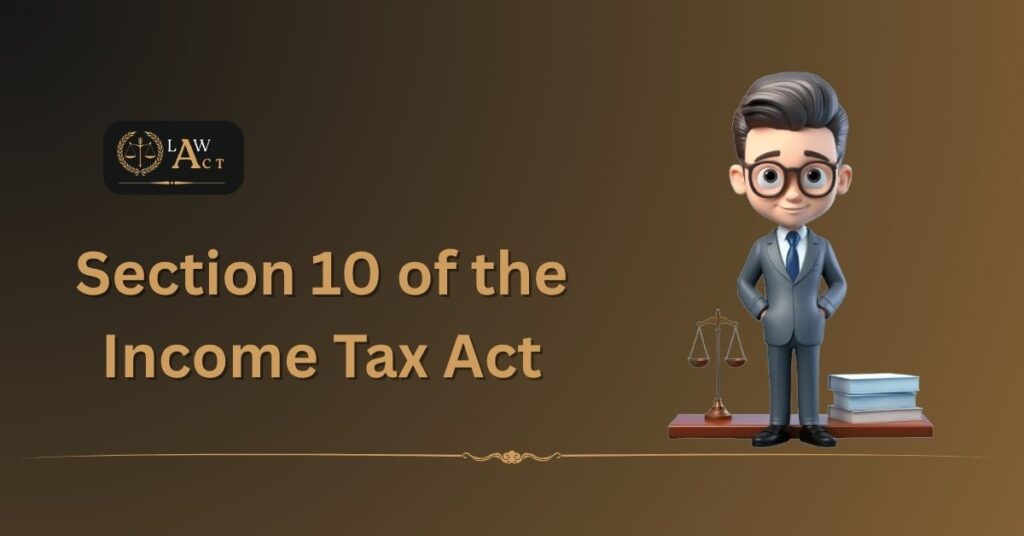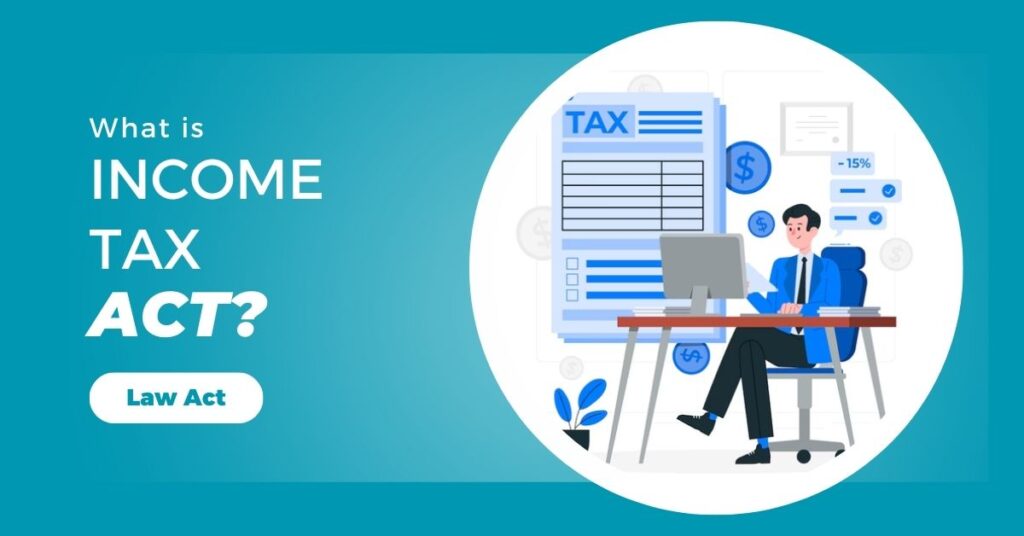Section 10 of the Income Tax Act is one of the most important sections when it comes to tax exemptions in India. It tells us about the different types of incomes that are not taxed. In other words, even if you earn certain types of income, you may not have to pay tax on them if they fall under Section 10.
What is Section 10 of the Income Tax Act?
Section 10 of the Income Tax Act lists several types of incomes that are fully or partly exempt from tax. This means that even though you receive that income, it is not added to your total income while calculating tax. This section helps many individuals, companies, and organizations to save money by not paying tax on certain earnings.
This section applies to many types of people – salaried employees, business owners, agriculturists, members of Hindu Undivided Families (HUFs), and even charitable institutions. The goal is to reduce the tax burden in specific situations where the government wants to provide relief or promote certain activities.
Why is Section 10 Important?
Section 10 is important because it allows people to legally avoid paying tax on certain incomes. It encourages activities like agriculture, education, and charitable work by making the income from these activities tax-free.
For salaried individuals, it includes things like House Rent Allowance (HRA), Leave Travel Allowance (LTA), and gratuity, which can help reduce tax liability. For others, it may include agricultural income, scholarships, or income from retirement funds.
By knowing about these exemptions, you can make better decisions about your income, investments, and even career choices.
Key Exemptions Under Section 10
Let’s look at some of the most common types of exemptions available under Section 10. Here’s a table to help you understand them better:
| Clause | Type of Income | Who Can Claim It | Conditions / Limits |
|---|---|---|---|
| 10(1) | Agricultural income | Farmers, landowners | Must be from agricultural land in India |
| 10(2) | Income of a Hindu Undivided Family (HUF) | Members of an HUF | Must be received from a family estate |
| 10(5) | Leave Travel Allowance (LTA) | Salaried employees | Exemption for 2 journeys in 4 years |
| 10(10) | Gratuity | Employees | Up to ₹20 lakh for non-government employees |
| 10(10A) | Pension/commuted pension | Government and private employees | Commuted pension partly/fully exempt depending on employer |
| 10(10C) | Voluntary retirement compensation | Employees taking VRS | Up to ₹5 lakh exemption |
| 10(13A) | House Rent Allowance (HRA) | Salaried employees | Subject to certain conditions |
| 10(14) | Special allowances | Salaried employees | Includes travel, uniform, helper, etc. |
| 10(16) | Scholarships | Students | Fully exempt if used for education |
| 10(23C) | Income of charitable or educational trusts | NGOs, educational institutions | Must be registered and used for charitable purposes |
These are just a few of the popular exemptions. Section 10 has many more sub-sections, each targeting a specific type of income or activity.
More About Popular Exemptions
Let’s now look at some of these exemptions in more detail.
1. Agricultural Income [Section 10(1)]
Agricultural income is completely exempt from tax in India. This includes income from farming, rent received from agricultural land, and even sale of agricultural produce. However, it must come from land within India, and the income should be purely agricultural.
This exemption helps support farmers and the agricultural economy. It is one of the oldest and most well-known exemptions.
2. House Rent Allowance (HRA) [Section 10(13A)]
If you are a salaried employee and live in a rented house, you can claim exemption on the House Rent Allowance (HRA) you receive. The amount of exemption depends on:
- Your salary
- The HRA received
- The rent you pay
- Whether you live in a metro city or not
This helps reduce your taxable income and is very useful for people who live in cities where rent is high.
3. Gratuity [Section 10(10)]
Gratuity is a lump sum payment made by an employer to an employee at the time of retirement or resignation. Under Section 10(10), gratuity is exempt up to a certain limit (₹20 lakh for private-sector employees who are covered under the Payment of Gratuity Act).
This exemption encourages employees to continue long-term service with a company.
4. Scholarships [Section 10(16)]
If you are a student receiving a scholarship for your education, that amount is exempt from tax. This helps promote education and reduces the burden on students and their families.
Scholarships granted by the government, institutions, or private organizations all qualify, as long as they are used for educational purposes.
5. Leave Travel Allowance (LTA) [Section 10(5)]
LTA is given by employers to employees to help cover the cost of travel within India. Under Section 10(5), this amount is exempt from tax for two journeys in a block of four years. You must actually travel and submit proof to claim this exemption.
It covers only domestic travel and not international travel, and only certain modes like air, rail, or bus are allowed.
Who Benefits Most From Section 10?
Section 10 benefits salaried people, retired employees, students, farmers, and even charitable organizations. By using this section correctly, taxpayers can legally save money and reduce their tax liability.
Employers also benefit, as they can design salary packages that include allowances and exemptions that help attract talent. For example, offering HRA, LTA, and medical allowances can reduce the overall tax burden for employees.
Organizations involved in charitable work, education, or religious services also benefit from income tax exemptions under various sub-clauses of Section 10.
How to Claim Section 10 Exemptions?
To claim exemptions under Section 10, you need to:
- Maintain proper records – Like rent receipts, travel bills, and proof of scholarships.
- Submit proofs to your employer – Especially for HRA, LTA, and other salary-related exemptions.
- Mention exemptions in your ITR – While filing your Income Tax Return, you must clearly show exempt income in the correct section.
Make sure to keep documents safely in case the tax department asks for them later.
Conclusion
Section 10 of the Income Tax Act is a powerful tool for saving tax legally. It offers exemptions on many types of income, especially for salaried employees, students, and organizations doing social work. Understanding these exemptions can help you plan better, file your taxes correctly, and save more money.
Always consult a tax expert or use online calculators to make sure you’re claiming the correct exemptions. You can also explore the full Income Tax Act for more legal references.
Also Read:
- Section 1 of the Income Tax Act
- Section 54 of Income Tax Act
- How to Register for VAT in UAE
- Income Tax Budget 2025: What’s New?
- Section 92BA of the Income Tax Act
Frequently Asked Questions
What is Section 10 in income tax law?
Section 10 of the Income Tax Act lists types of income that are exempt from tax. This means even if you earn such income, you don’t have to pay tax on it. It includes allowances, pensions, agricultural income, and more based on specific rules and limits.
Is agricultural income fully tax-free?
Yes, agricultural income is fully tax-free under Section 10(1), but only if it comes from agricultural land located in India. It includes income from farming, rent from agricultural land, and selling agricultural produce. This exemption helps support farmers and the agriculture sector in India.
Can salaried employees claim HRA exemption?
Yes, salaried people who get House Rent Allowance (HRA) can claim exemption under Section 10(13A) if they live in rented accommodation. The exempt amount depends on rent paid, salary, and whether the city is metro or non-metro. Proper rent receipts are needed for claiming it.
Is pension income taxable or exempt?
Commuted pension (lump sum) may be exempt under Section 10(10A), while uncommuted (monthly) pension is usually taxable. Government employees get full exemption on commuted pension. Non-government employees can get partial exemption depending on whether they receive gratuity or not.
What is exempt under Leave Travel Allowance?
Leave Travel Allowance (LTA) under Section 10(5) is exempt for domestic travel made by the employee and family. It can be claimed twice in a block of 4 years. Only actual travel costs are exempt, not food or hotel bills. You must keep travel proof.
Are scholarships exempt from tax in India?
Yes, scholarships granted to students for educational purposes are fully exempt from income tax under Section 10(16). The exemption applies as long as the scholarship is used for academic expenses. You don’t need to pay tax on this income, even if it’s a large amount.
What is the limit for gratuity exemption?
Under Section 10(10), gratuity is exempt up to ₹20 lakhs for non-government employees who are covered under the Payment of Gratuity Act. For government employees, gratuity is fully exempt. This benefit is available only once in a lifetime, so it must be used wisely.
Is income of charitable trust tax-exempt?
Yes, income of registered charitable or educational institutions is exempt under Section 10(23C), if used for the intended public benefit purpose. These trusts must follow specific rules and spend most of their income on charitable work to enjoy the tax exemption.



